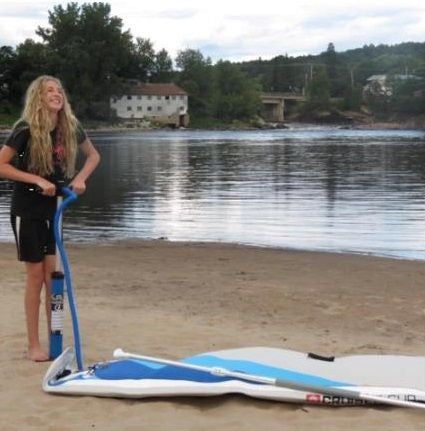When selecting your first, or a new stand up paddle board, there is one main decision to be made (long before you pick sizing, model, or style): should you buy an inflatable or non-inflatable SUP.
If buying a board for yourself, friend, or family member, one thing to strongly consider, is which is safer? We have proudly offered both styles of boards for many years, however, we are steadfast in our opinion that non-inflatables, (which we refer to as rigid boards), are by far the safest and most convenient option. We have 15 years of SUP and 25 years of rigid surf board sales experience to form and support our opinions.
Keep reading to find out the reasons why, but first we will take a look at just what rigid and inflatable SUP boards are, and how they differ in construction.

What is a Rigid Stand Up Paddle Board?
There are infinite variations of rigid board constructions, but the basis for all is a shaped EPS foam core. The core is covered (or laminated with), layers of fiberglass, and/or wood, bamboo, innegra, carbon, and other materials (such as polycarbonate). The differences between rigid board constructions is a topic for another blog post. However, a shaped EPS foam core that is laminated with other materials, makes up 99% of rigid boards on the paddle board market.

What is an Inflatable Stand Up Paddle Board?
As you can tell from the name, inflatables need inflating by a pump. They can also be called iSUP’s or blow ups. The are made of a PVC vinyl and drop stitch material (two layers of PVC connected by thousands of threads) that is glued together at the middle seam, to create a board that takes shape as you inflate it.
With the basics of what both boards are, lets look at why rigid boards are so much safer.

Why Are Rigid Paddle Boards Are Safer Than Inflatables Paddle Boards?
Inflatables derive their shape and buoyancy when filled with air. Air can leak out of things that are filled with it. I am sure you have at some point experienced a flat tire on a car, bicycle or air mattress. Let’s take a look at this little scenario and see how it would play out for both a paddle boarder on a rigid board and iSUP:
You are enjoying a great day on the water (wearing your leash of course, as you are a safe and smart paddler) when your inflatable paddle board suddenly starts leaking air….
Rigid Paddle Board Safety
If you are on a rigid board, this scenario is impossible and can’t happen. Rigid boards are not air filled, and can’t leak air, thereby losing their buoyancy. Not even a little bit. If you are paddling a rigid board, there is nothing that can fail while paddling that could ever impact its ability to support your body weight.
If you are on the water and your board somehow sustains damage (i.e you hit a rock with great impact) the worst case scenario is you have damage board a little, the board may absorb a little water (which doesn't affect buoyancy) and you learn to avoid rocks next time paddling. While it is too bad you damaged your board, you can still safely paddle back to shore to assess the damage and get it fixed. Even if your board was to break into two pieces (from a huge wave), both pieces will still float! A rigid board will always have the ability to get you safely back to shore. The same doesn’t apply to inflatables, as you will find out if you keep reading….

Inflatable Paddle Board Safety
If you are on an iSUP, the scenario can be much different. An iSUP that is full of air and holding pressure is safe, don’t get us wrong. The issue of safety comes up when an iSUP stops holding air pressure. This is especially the case as iSUPS get older.
Lets say you have just finished the sweaty, and time consuming effort of inflating your board (yes – inflatables are neither easy or convenient to actually inflate) and head out on the water. A few hundred yards from shore you start to hear a hissing sound. Hissing is never a good sound on anything full of air. That means your board is losing air. This could be from a leaking valve, or a small pinhole puncture. Even if it is a very slow leak, it will have likely triggered a full on panic mode paddle back to shore. Before going out again you are going to have to figure out the source of the leak and fix it. A small slow leak is one thing, but what about seam failure?
iSUP’s are glued together in the middle and have seams that run the entire circumference of the board. If one of these seams fails, your board loses all its air instantly, just the same as if you slice or puncture a tire while driving your car. There is no warning, and suddenly there is a gaping 12 inch hole on the side of your board. The result is that your iSUP board is instantly (and I mean instantly) something you can no longer stand on and paddle. This is where the real difference in safety between iSUP and rigid boards comes out - especially as inflatable boards age.
Best case, you can swim back to shore or be rescued, worst case could be life threatening if you are far from shore, in cold water, or not a strong swimmer. Being stranded in the water, without a board that floats, is terrifying as things like hypothermia, shock, and exhaustion can very easily come into play, as your fully deflated iSUP will be of no use. An inflatable without air pressure is 100% useless as not only a board, but also as a flotation device in an emergency situation. This is why many countries are starting to mandate that paddle boards must have a double air chamber. Never paddle an inflatable board further from shore than you are comfortable swimming to shore.

Rigid Paddle Boards Are Safer Than Inflatables Paddle Boards
Stand up paddle boarding is a great way to get out on the water, to have fun and get fit. But, it is a water sport, and like all sports, safety needs to be considered when picking not only your paddling conditions and location, but also your gear.
We are not saying an inflatable holding its air pressure isn’t safe, it is the outcome of what happens when it stops holding air pressure that you should consider. Very little, if anything, can be done to a rigid board to not allow you to still stand on it and paddle. However, with iSUP’s there are so many things that can cause a loss of air pressure from valve leaks, to pin holes, cuts (from rocks) to blown seams. For all these reasons, whenever someone asks us which is safer, our answer is always that rigid boards are safer than inflatables.
This is reflected by 90% of our customers choosing rigid boards over inflatable boards.
Did we miss something? Maybe you don’t agree with us? Comment below or email us at info@cruisersup.com.

